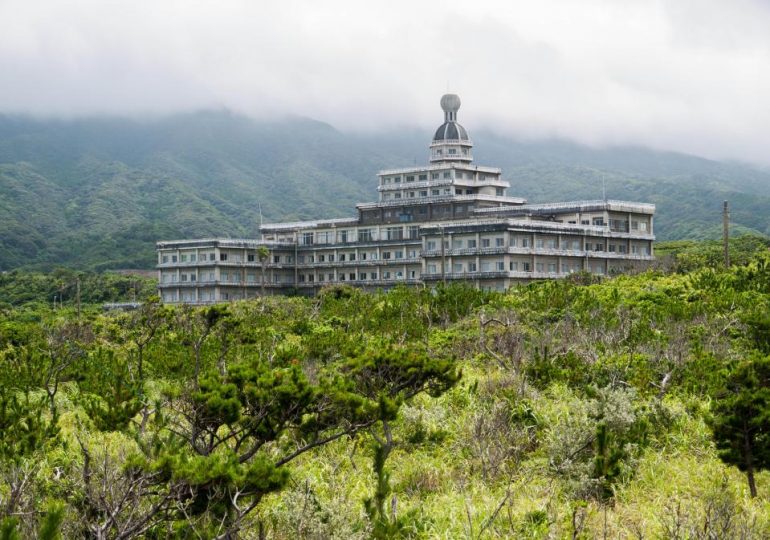A STUNNING hotel located in what was once dubbed “Japan’s Hawaii” has been left to elements for over 15 years.
The derelict Oriental Resort Hotel on Hachijojima Island was one of Japan‘s biggest hotels before it was deserted.
The beauty of the grand Hachijo Royal Hotel is slowly fading after being abandoned 17 years agoExclusivepix Media
The hotel took design inspiration from French Baroque architectureExclusivepix Media
Exclusivepix MediaA pool lies covered in moss after almost two decades without maintenance[/caption]
Exclusivepix MediaThe humid climate has resulted in the spread of mould and plants throughout the site[/caption]
Opened in 1963, the luxury hotel attracted guests from all over the globe with its grand, regal appearance.
The lavish accommodation, which has now been abandoned for 17 years, features an ornate fountain adorned with plaster statues that have now been left to rot in the humidity.
A grand stairway leading up into the hotel has been photographed overgrown with weeds and shrubbery – making it appear more like a jungle than a glamorous establishment.
Haunting photos of the hollowed-out 252-room hotel, show an empty outdoor swimming pool in the rear garden area.
Trees and plants have taken over the space and patches of moss and grime fill the tub that was once filled with paying guests.
A stagnant car with an open boot waits chillingly outside the hotel, as it slowly becomes devoured by orange rust.
The hotel complex was even audacious enough to embellish its then company’s president Eiji Yasuda with his own statue alongside his prized horse – which now looms over the empty hotel gardens.
Urban explorers who have visited the crumbling Hachijo Royal have revealed images of the interior which has been severely degraded by the tropical climate.
Huge bedrooms with rotting beds and broken TV sets lay eerily empty as large leafy plants slowly take over the space.
In other rooms, moldy wallpaper peels off the once vibrant, green walls and chandeliers can be seen smashed to pieces on the ground.
Chairs and stools have been left in place by the last person to have used them and a grand piano sits alone in a white room as the wooden walls and carpet are consumed by grime around it.
On the ground floor, a telephone box looms in a corner with its rust-covered door swung wide open.
Next door a once-lavish hall has been left littered with mountainous piles of rubbish, including plastic bags, bottles, broken boxes, and other debris.
But some rooms have chillingly remained almost perfectly preserved.
A black and red marble staircase has retained its grandeur, despite being covered in a thick layer of dust.
Some hotel bathrooms look remarkably untouched with towels still hung over the side of bathtubs.
And the massive kitchen, which would have once been filled with bustling chefs and clanking plates, has bizarrely remained in pristine condition – bar a few spots of rust.
Before the hotel opened its doors to the public, the Japanese Government made it nearly impossible for the average Japanese to acquire a passport to travel.
As comparatively close destinations such as those in Asia and the Pacific were off-limits, the tourism industry looked nearer to home to meet domestic tourists’ demands for sun, sea, and sand.
Fortunately, the Izu Islands included the subtropical volcanic island of Hachijo-jima, just 178 miles south of Tokyo.
Short travel times by ferry and a ready-made airport relinquished from Imperial Japanese Navy control meant the island could quickly scale up and handle large numbers of tourists.
The government promoted the island as the Hawaii of Japan and soon the island saw a rapid influx of investment and property development.
The jewel in the crown was the lavish Hachijo Royal Hotel, which was heavily influenced by French Baroque architecture.
With its glamorous appearance, Greek statues, and idyllic views, it stood proudly as a showcase of the economic boom taking place on the mainland.
But in the 1990s, after around 30 years in business, cracks began to emerge.
Overseas travel became the norm rather than the exception and the idea of hanging out on black volcanic sands no longer held the same appeal.
With world-class beaches only a little further afield in places such as Guam, Hawaii, and Thailand, Hachijo-Jima struggled to reinvent itself and closed in 2006.
But the Hachijo Royal is not the only luxury hotel that has been forced to close its doors and become a home for nature.
A luxury seaside hotel left abandoned 14 years ago has gone on sale for £8million after falling into serious disrepair.
Hotel Itapirubá, on the coast in Laguna, boasted a whopping 200 rooms, tennis courts, and a nightclub, but has now been left to rot under the Brazilian sun.
In Tenerife, a 22-storey hotel, also on the beachfront, has sat empty for 50 years.
Haunting photographs show the inside of the mammoth resort – which was supposed to house 741 individual apartments.
And in North Korea, the enormous Ryugyong Hotel has dominated the Pyongyang skyline for decades – despite hosting no guests.
The £1.6billion triangular hotel has never hosted a single guest, and has been dubbed the “Hotel of Doom”.
Exclusivepix MediaA room slowly being devoured by plants at the lavish Hachijo Royal Hotel[/caption]
A hotel bathroom looks remarkably untouched by its 10 years of abandonmentExclusivepix Media
An abandoned car is left derelict by the ravages of the last 17 yearsExclusivepix Media
A kitchen that would have been filled with bustling chefs and clanking plates is now slipping into disrepairExclusivepix Media
Exclusivepix MediaA once-stylish hall now lies littered with debris and rubbish left behind[/caption]
A grand piano sits alone in a white decaying roomAlamy
Exclusivepix MediaRooms within the hotel are slowly becoming consumed by plants and grime[/caption]
Exclusivepix MediaA stairway has retained its grandeur, even after 17 years of abandonment[/caption]
Leave a comment
















